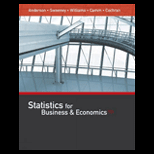
1.
Compute the
b.
Suggest an appropriate number of boxes in the weekly sample that must fail to meet the standard weight of banana flavored marshmallows in order to shut down the production if the goal is to be achieved.
c.
Find the level to which Ms. Finkel have to reduce the percentage of 16-ounce boxes of Go Bananas that fail to meet the standard weight of banana flavored marshmallows when the process is working properly in order to reduce the probability that at least five of the sampled boxes fail to meet the standard of 0.01 or less.
Trending nowThis is a popular solution!

Chapter 5 Solutions
STATISTICS F/BUSINESS+ECONOMICS-TEXT
- Show all workarrow_forwardplease find the answers for the yellows boxes using the information and the picture belowarrow_forwardA marketing agency wants to determine whether different advertising platforms generate significantly different levels of customer engagement. The agency measures the average number of daily clicks on ads for three platforms: Social Media, Search Engines, and Email Campaigns. The agency collects data on daily clicks for each platform over a 10-day period and wants to test whether there is a statistically significant difference in the mean number of daily clicks among these platforms. Conduct ANOVA test. You can provide your answer by inserting a text box and the answer must include: also please provide a step by on getting the answers in excel Null hypothesis, Alternative hypothesis, Show answer (output table/summary table), and Conclusion based on the P value.arrow_forward
- A company found that the daily sales revenue of its flagship product follows a normal distribution with a mean of $4500 and a standard deviation of $450. The company defines a "high-sales day" that is, any day with sales exceeding $4800. please provide a step by step on how to get the answers Q: What percentage of days can the company expect to have "high-sales days" or sales greater than $4800? Q: What is the sales revenue threshold for the bottom 10% of days? (please note that 10% refers to the probability/area under bell curve towards the lower tail of bell curve) Provide answers in the yellow cellsarrow_forwardBusiness Discussarrow_forwardThe following data represent total ventilation measured in liters of air per minute per square meter of body area for two independent (and randomly chosen) samples. Analyze these data using the appropriate non-parametric hypothesis testarrow_forward
